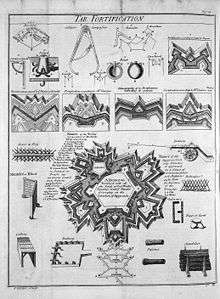Hornwork

Feature 'f' is a hornwork. From Cyclopaedia.

hornwork

The Weber Church of Zittau inside a hornwork (Europaeum Theatrum, Volume 5, Plate 12. Published in 1651 in Frankfurt am Main).
A hornwork is an element of the trace italienne system of fortification. It consists of a pair of demi-bastions with a curtain wall connecting them and with two long sides directed upon the faces of the bastions, or ravelins of the inner fortifications, so as to be defended by them.[1]
The hornwork was used to extend the fortified area in a particular direction to prevent the enemy occupying an area of high ground or simply strengthen the overall fortifications in the expected direction of attack.[2] A crownwork serves a similar purpose, but unlike a hornwork, it contains full bastion.
Notes
- ↑ Griffiths 1862, p. 262.
- ↑ Editor 1830, p. 590.
References
| Wikimedia Commons has media related to Hornwork. |
- Griffiths, Frederick Augustus (1862). The artillerist's manual, and British soldier's compendium (9 ed.). Parker & Son.
- Editor (1830). "A Popular View of Fortification and Gunnery, No. I. 49, No. II. 316, No. III. 586". The United Service Journal and Naval and Military Magazine. London: Henry Colburn and Richard Bentley. part 1.
This article is issued from Wikipedia - version of the 10/30/2016. The text is available under the Creative Commons Attribution/Share Alike but additional terms may apply for the media files.